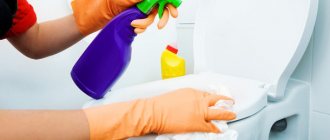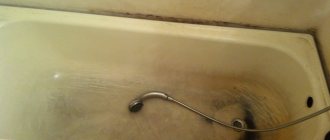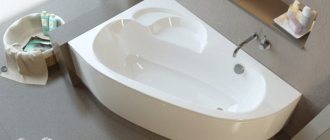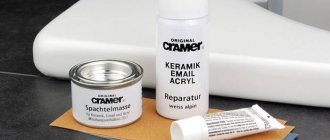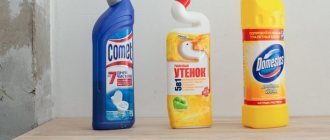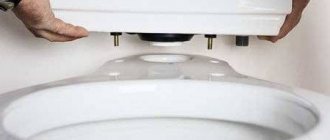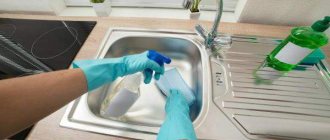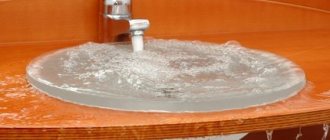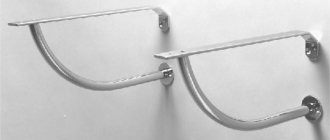How to care for an acrylic bathtub
To begin with, it must be said that the conditions for caring for a bathroom in our country are somewhat different from the conditions in other countries. This is due to the quality of the water we use.
In this regard, we will need to more carefully and regularly take care of the acrylic bathtub.
- It is necessary to use only liquid care products for acrylic surfaces. These preparations should not contain abrasive substances that can scratch the delicate structure of this material;
- You can really restore the shine of the surface by using a soft cloth soaked in furniture polish;
- Stubborn stains can be removed using household products designed for smooth surfaces;
- Two or three times a month it is necessary to thoroughly clean the acrylic bathtub with special detergents, of which there are a large number. Instructions for use are written on the packaging.
- To avoid the formation of rust on the surface of the bathtub, you need to tighten the taps tightly.
- It is recommended to bathe animals by protecting the bottom of the bath with a mat. You will avoid unwanted scratches, and the surface will not slip.
- Each time after using the bathtub, it should be cleaned with a mild detergent and rinsed with plenty of water. Next, wipe the bath with a dry towel and leave it like that until next use.
- Don't despair if you find a few superficial scratches. They can be easily cleaned with fine-grained sandpaper. Next, these places are simply polished with liquid detergent.
Compatibility of detergents with acrylic surfaces
Is it possible to wash an acrylic bathtub with Domestos or a mixture of substances? It is not advisable to mix with:
- Formaldehyde - they are not compatible with acrylic.
- Chlorine - its use forms pores, shortening the service life of the product.
- Acetone , ammonia - corrode the walls.
Domestos, Sanox, Pemolux and Selite contain hydrochloric acid, which destroys protection. Initially, it is bleached, but then it absorbs plaque, becoming dirty faster. Therefore, such detergents cannot be used.
Possible contamination of an acrylic bathtub and methods of elimination
Sooner or later you will have to deal with different types of pollution, so you need to be prepared to quickly eliminate them. Let's list the most common ones:
- Hardened and dried dirt. If stains cannot be removed with a mild detergent and a sponge, you should let the dirt soak first. To do this, add hot water to the bath and leave for at least half an hour. If the bathtub rim is dirty, place a damp cloth soaked in liquid detergent on the stain.
- Ordinary dirt. This is the most common type of contamination. It is he who is eliminated more easily than others. Just wet the sponge and pour detergent on it, and then lightly wipe the enamel.
- Moisture-resistant and stain-resistant. To remove sand or clay deposits, a specialized composition or a regular detergent is applied to them, which must first be absorbed into the thickness of the stain. But if stains from tree resin, plaster or lime appear in the bathroom, you will have to make a lot of effort to get rid of the problem.
How to remove minor scratches and damage
During the operation of an acrylic bathtub, small scratches and cracks may appear, which methodically destroy a thin layer of polymer. They definitely need to be removed. This is a big topic, so in this paper we will tell you how to remove scratches caused by using detergents.
For this you will need:
- polish (epoxy resin) or liquid acrylic;
- sandpaper of 2 types: P60 and P240;
- white spirit or acetone;
- putty knife;
- plastic film if liquid acrylic is used;
- paper napkin (piece of rag);
- felt.
Repairs are performed in the following sequence:
- the damaged surface is treated first with medium-grained (P60) and then with fine-grained sandpaper until a matte surface appears;
- the treated area is degreased using acetone (white spirit) and a napkin;
- polish is applied to the scratch with a spatula;
- After 24 hours, the applied composition is polished with felt.
If liquid acrylic is used, it is covered with plastic film for several days, after which it is sanded with fine-grained paper. The process is completed by applying polish and polishing the repaired area with felt.
Attention: if the color of the stain is different (it was not possible to match), then before applying the polish with an airbrush, a color correction of the repaired scratch is carried out.
The right way to clean an acrylic bathtub
How to care for an acrylic bathtub and how to clean it is the main question of the housewife. An acrylic bathtub can be found in almost any home. They are practical, cheap, look nice and can come in any shape or type. Withstands a lot of weight, up to 150 kg, they are even made to order.
The main feature of an acrylic bathtub is that it heats up many times faster than cast iron and is easily installed indoors. But not everyone decides to purchase such an attribute, because they believe that caring for acrylic should be specific. This is not always the case, but such a bathroom requires special care.
What can happen to an acrylic bathtub:
- glossy shine disappears;
- streaks and yellow spots appear;
- water stone builds up;
- the surface is scratched;
- Some parts rust.
These are the main problems that you may encounter when using an acrylic bathtub. You can fight them; some of them can be easily removed thanks to homemade recipes.
For cleaning you will need a few items - gloves, lint-free rags, sanding paper and a spray bottle. If desired, you can also use a gauze face mask to prevent breathing in the fumes of cleaning products.
To restore the shine in your bathroom, you need to periodically rub it with polish applied to a soft cloth. Water stone can be removed using citric or acetic acids: dilute in plain water 1:7 (a liter of water and 7 tablespoons of acid).
After cleaning, rinse the area well, then polish with a soft cloth until it has a glossy shine. If the scratch is deep, then you can use liquid acrylic; it is sold at any hardware store.
Cleansing with acetic or citric acid gives excellent results if you fill the bathtub with it overnight:
- fill the bathroom with warm water;
- add acetic/citric acid (1:7);
- Leave the resulting mixture in the bathroom for 12-14 hours;
- pour everything out, rinse and wipe with a dry cloth.
When purchasing acrylic bathtubs, experts advise carrying out preventive measures, then over time there will be no problems with acrylic: rinse the surface with warm water, wipe dry after use, and carry out complete disinfection at least once a year.
All this together will help keep the surface and integrity of the bathtub in excellent condition for many years. Before you start cleaning the surface, you need to adhere to several rules:
- work only with gloves - some solutions (especially special, store-bought ones) can damage the skin and mucous membranes;
- exclude detergents that contain ammonia, acetone, chlorine, powder, they can seriously damage acrylic and make it yellow and unattractive;
- the sponge chosen is soft, lint-free, hard washcloths are excluded;
- After all cleaning actions, rinse the surface well with warm water;
- check the faucet, do not allow water to drip from the tap, this will lead to rusty streaks in the bathroom;
- when bathing pets or washing dishes, it is advisable to cover the bottom with something, a rag or a special rubber mat, so as not to damage the surface;
- Very hot water can also damage the surface, turn it yellow and remove the glossy shine.
Many people have a reasonable question: does an acrylic bathtub require constant cleaning and maintenance? The answer is clear - yes, no less than ordinary cast iron bathtubs. According to hygiene rules, you need to wipe and wash the surface with soap and water every time after bathing.
And it is advisable to use a cleaner for acrylic bathtubs. If you don't have one, you can prepare it at home. To do this, you will need baby soap (20 g), boiling water (500 ml), soda (100 g), aromatic oil (if desired). The mixture is prepared quickly:
- baby soap is grated on a coarse grater;
- pour boiling water over the resulting shavings, stirring until completely dissolved;
- then add soda and mix well;
- add a couple of drops of aromatic oil if desired for a more pleasant smell.
The resulting creamy paste effectively removes yellow stains, dirty marks and other imperfections from an acrylic bathtub. The best effect is achieved by the paste if you spread it in a thick layer and leave it for half an hour. After this, it is removed with a sponge and the bath is wiped dry with a rag.
Cleaning products must be chosen carefully, excluding hard, powdery products - they can damage the glossy layer of acrylic. As a result, yellow areas and dark spots appear, which in the future are almost impossible to remove, but it is better to paint over them with acrylic paint.
Features of acrylic products
Intricately configured sanitary ware allows you to create a unique interior in large and small bathrooms. It makes it possible to emphasize the individuality of the owners, adds comfort and brings a special atmosphere with its very presence.
What is a bath?
An acrylic bathtub, in addition to its original shape, has its positive and negative sides, which must be taken into account during its operation and maintenance.
So, you should immediately make sure which product you are going to live with side by side - a cast acrylic structure with a thickness of 5 mm or more, or a 1- or 3-layer plastic variation covered with a 2-3 mm layer of acrylic.
If we are talking about the first option, then there will be no doubt about the impeccable quality of the product. The manufacturer will confirm this by providing a 10-25 year guarantee on acrylic.
In the second case, you will have to make friends with a thin coating, which will last for 3-5 years, and maybe even 10. This depends on the specifics of use and the promises of the company that made the bath.
We will not consider the option of a parody of an acrylic product with a top layer of 0.5 mm - a bad fake cannot be called an acrylic bathtub. The coating will wear off after 6-8 months of use.
In addition to the thickness of the acrylic layer, the difficulty of cleaning is influenced by size and functionality - the larger the bowl and the more pleasures it can offer, the more difficult it is to clean.
As for additional functions, acrylic models are equipped with hydromassage equipment, lighting, sound effects and other interesting devices.
It turns out that the original shape of the bowl, non-standard size, and many nozzles will influence the complexity of the procedures for caring for it. And the more additional equipment, the more time will need to be devoted to washing and disinfecting the product.
What's wrong with an acrylic surface?
It is important to carefully read the manufacturer’s recommendations after purchasing a bathtub. The fact is that many companies provide a guarantee on acrylic coating and all kinds of equipment only if certain rules are observed.
Thus, sometimes the instructions indicate that the warranty begins to apply only after installation of the product by a responsible employee of the company from which it was purchased. It turns out that if you install it yourself, you can lose the 10-year warranty.
Another feature that you should definitely pay attention to before starting to use the bath is the manufacturer’s recommendations for its operation. It is this section that needs to be carefully studied so that in the future you do not lose the product and the guarantee that the problem will be corrected at the expense of the seller.
A polymer bathing container is significantly different from its steel and cast iron counterparts - it requires a more careful attitude. Especially if the acrylic layer is very thin.
The acrylic thicket is afraid of fire, hot water, aggressive chemicals, prickly and sharp things and other troubles. To extend its life, you need to carefully monitor your actions in relation to the acrylic bathtub.
In addition, manufacturers are categorically against bathing animals in the bowl - it should only be used for personal hygiene. Therefore, scratches from claws that spoil the appearance of the product are not covered under warranty.
The way out of the situation is to have a special bedding for your pet’s water treatments. It can be a soft thick towel or a silicone mat. Before bathing, it should be placed on the bottom of the bath. True, such a device will not protect against scratches on the sides.
Folk cleaning products
You can no less effectively clean an acrylic bathtub using improvised means. If the problem is only rust and yellow plaque, the following options will help:
- Apply soda paste to problem areas, leave for a few minutes and rinse with warm water.
- Heat the vinegar essence and combine with table salt. Use the resulting mixture to wipe off rusty stains on the plastic.
- Dilute borax powder and dampen a rag. Wash the surface with progressive movements. All limescale comes off instantly.
- A solution of ammonia and water cleans well.
- The dark spots can be rubbed with regular toothpaste and washed off after a few minutes. This technique returns shine and purity to acrylic.
It is safer for acrylic if all of the listed ingredients are not applied in pure form, but diluted in a filled bath. The result will have to wait longer, but the likelihood of surface damage will be reduced to zero.
Recommendations for cleaning depending on the type of contamination
There may be various types of contaminants on the surface of the bowl. Each of them has its own detergents. For clarity, let’s summarize the problems that arise and how to solve them in a table.
Table 1. Types of contaminants and detergents to remove them.
| Type of pollution | Cleaning products |
| Yellowness | Toothpaste; hydrogen peroxide and vinegar; dry mustard (powder) and baking soda |
| White coating (lime) | Table vinegar (9%); baking soda; lemon acid |
| Rust | Lemon juice; Ammonia and hydrogen peroxide |
| Silicone sealant | Lemon acid; White Spirit; vinegar essence |
| Glue | Lemon acid |
Now let’s look in more detail at how to clean an acrylic bathtub from each type of contaminant.
Yellowness
A bathtub can turn yellow for several reasons: there is a lot of iron in the water; insufficient quality of cleaning was carried out at the disinfection station to remove chlorine impurities; irregular care was provided, etc. Therefore, it is first advisable to figure out why it turns yellow in order to use a cleaning agent that can solve the problem. If this is not possible, then you need to try using the recipes below one by one.
Recipe No. 1. Take hydrogen peroxide and table vinegar (9%) and mix in a ratio of 1:3. The resulting solution is poured into a spray bottle and sprayed onto the stain. If you don’t have a sprayer, you can apply the product to the yellowness with a sponge or soft cloth. After a quarter of an hour (15 minutes), the stain is thoroughly washed and then wiped dry.
Recipe No. 2. Mustard powder is mixed in equal proportions with baking soda and diluted with warm water to a paste. Apply to yellowed areas for 30 minutes, then wash off with warm water. The bowl is dried with a hairdryer or wiped with a dry cloth.
Recipe No. 3. The most effective, but at the same time the most expensive of the folk methods to remove yellowness and return the shine to the bath - toothpaste. She:
- perfectly removes yellowness, regardless of the source of formation;
- having a soft structure, it eliminates the risk of scratches during the cleaning process, compared to soda;
- does not contain aggressive substances, unlike vinegar and citric acid.
There are two methods for cleaning with paste.
Method 1. With this cleaning method, the paste is applied locally, only to damaged areas:
- toothpaste is applied in a thin layer to yellowed spots;
- after 5 minutes, the areas are wiped with a sponge;
- The cleaning agent is washed off with warm water, after which the font is wiped dry.
Method 2. If it is necessary to treat the entire surface, paste is applied to the sponge. After this, one zone is processed, for which the applied cleaning agent is enough. Having completed work with one portion of paste, the bath is washed with warm water, after which the procedure is repeated with a new area. And so on until the entire surface of the bowl is cleaned. At the end of the work, the font should be wiped with a dry cloth.
Limescale
You can remove limescale with a 9% solution of table vinegar. Considering that vinegar behaves aggressively towards acrylic, you need to pour it into a bathtub filled with warm water in a volume of no more than 1 liter and stir well. In this state, the bath is left for about 10-12 hours, no more. Otherwise, unwanted chemical reactions will begin. After the set time has passed, the water is drained, the bowl is rinsed first with warm and then cold water and wiped dry.
Many housewives add citric acid, soda or salt to the water along with vinegar. Such additives not only speed up the process of eliminating limescale, but also restore acrylic to its original shine. The only requirement: the crystals of the added substances must be completely dissolved in water.
Baking soda can also remove deposited limescale. But when using it, you need to remember that it is a good abrasive - it’s not for nothing that housewives use it to scrub the dirtiest kitchen utensils. Therefore, you need to handle it very carefully: either pour water into the bath, pour a pack of product into it, leave for 1 hour, drain the solution, rinse and wipe dry, or use it as a paste. But the latter option is only suitable for removing individual stains, which is rare.
The technology for getting rid of limescale with gruel is simple:
- soda diluted to the consistency of sour cream is applied to contaminated areas for 20-25 minutes;
- After the specified time, it is washed off with water, after which the bowl is wiped with a dry cloth.
You can also wash the font with citric acid. The method of application is similar to vinegar. To clean, you need 200 g of dry substance, completely dissolved in warm water - crystals that settle on the walls or bottom of the bath immediately react with acrylic.
Rust
Rust stains can be removed with lemon juice or a solution of ammonia and hydrogen peroxide.
Lemon juice. Freshly squeezed lemon juice is applied to the rust stain for an hour, no more. After this, the bath is washed and dried. To enhance the effect, many housewives grind table salt to a powder and mix it with lemon juice.
The gruel is applied to contaminated areas. After about an hour, everything is washed off with warm water, and the surface of the plumbing is wiped. Under no circumstances should you rub anything here - the shine will go away. If it was not possible to remove the rusty coating the first time, repeat the procedure.
Ammonia and hydrogen peroxide. Both substances are aggressive towards all types of acrylates. Therefore, their impact should be short - 5-7 minutes. But this time is enough to deal with fresh rust. For advanced cases, you will have to buy specialized products or use lemon juice.
Directions for use: ammonia and hydrogen peroxide are mixed in equal proportions. A little warm water is added to the resulting solution, after which the resulting product is applied to the browned areas using a tampon or sponge. After a maximum of 10 minutes, the solution should be washed off and the surface wiped.
Silicone sealant
Silicone sealant causes a lot of concern: no matter how you wash it, it turns black and becomes covered in mold. The problem can only be resolved in one way: replacing the silicone. But here another problem arises: the sealant is tightly glued to the acrylic.
In this case, a cloth soaked in one of the substances given in the table will help (citric acid must be dissolved). With their help, the silicone is rubbed off, gradually dissolving. Mandatory condition: every 7-10 minutes, the treated areas are washed with warm water.
Glue
You can remove glue residue from the surface of an acrylic bath using dissolved citric acid.
Important: The following recipes are designed for cleaning old stains. For regular care, other methods and concentrations of the substance are used, as described in the section “How to wash an acrylic bathtub.”
Jacuzzi cleaning rules
Whirlpool baths require a careful and responsible approach. It differs from standard models in the presence of nozzles through which the pump supplies directed water jets. Irregular use of the Jacuzzi leads to the formation of limescale and pathogenic microflora on the outlets. The cleansing rules are as follows:
- Fill the bathtub with hot water 6–8 cm above the level of the nozzles.
- Disable air massage, if present.
- Pour in a special cleaning composition. Dishwasher safe. To get the result, 50 ml is enough. For bactericidal treatment, use 150–200 ml of vinegar.
- Run the hydromassage equipment for 15–20 minutes. This technique allows you to remove dirt accumulated inside the injectors - it easily flows out.
- Drain the dirty water and refill the bath. Restart the hydromassage.
At the final stage, clean water will wash the insides of the nozzles. The bathtub is ready for safe use again.
It is not recommended to add chloride compounds as disinfection. They not only damage plastic, but also corrode silicone and rubber gaskets.
Useful care tips
If you adhere to the rules for using an acrylic bathtub, then problems with the coating, as well as minor scratches, will not arise. But unfortunately, it is not always possible to follow the recommendations. Firstly, pets - it is not always possible to provide your pets with a separate washing room.
So we have to put up with them in one bathroom, using an acrylic bathtub as a container for bathing animals and for taking water treatments for all family members. Therefore, you should purchase a repair kit in advance so that it is at hand at the right time.
Secondly, you need to be extremely careful when cleaning faucets - choose a product that will be safe for the bath. After all, random drops of aggressive liquid can spoil the impeccable gloss of acrylic.
Thirdly, be sure to use protective gloves - any, even the most harmless, product can harm the delicate skin of your hands.
Fourth, when purchasing a new acrylic cleaner, it is advisable to test its action on a small piece of the bathtub to make sure that it does not damage the acrylic layer of the bathtub.
Fifth tip - if you need to fill a basin or bucket made of metal or plastic with water, it is better to place it on the floor and use a shower head to fill it.
Sixth, if colored splashes get on the acrylic surface of the bowl, for example, when washing off hair dye, children's gouache or other colorful substance, you should immediately remove them using your arsenal of bath detergents. A stubborn stain will be much more difficult to remove than a fresh one.
Useful tips will help you avoid many problems and maintain the attractiveness of your bathtub.
When choosing special products, you need to pay attention that it is a substance in the form of a cream, gel, oil, suspension or liquid. Moreover, there should be no solid inclusions, aggressive acids or solvents in the composition of the correct acrylic care product.
Another important tip is to choose the type of product that matches the nature of the contamination. So, a gel to combat limescale is unlikely to cope with rusty water stains.
Inappropriate Techniques
Despite the strength of acrylic products, some products can damage it and are therefore prohibited for use:
- brushes with metal needles and stiff bristles;
- powders containing abrasive particles, including dry soda;
- cleaning gels containing strong acids that corrode acrylic surfaces;
- chlorine-containing products;
- acetone, formaldehyde and solvents that can cause deformation of acrylic;
- undiluted ammonia, concentrated alcohol, acid, alkali.
The listed products leave microscopic scratches on acrylic, leading to the disappearance of shine and dulling of the surface layer. Hydromassage units quickly fail due to deformation of silicone gaskets.
We recommend reading: Don’t give mold a chance: rating of the best means to combat mold in the bathroom
How to get rid of scratches on acrylic
It is not always possible to protect the bathtub from damage
Carelessly dropping metal objects or overzealous cleaning can cause scratches on the acrylic surface. But this too can be dealt with.
Scratches on acrylic appear as easily as they are removed. Therefore, you should not worry too much about them. Small scratches less than a millimeter deep can be easily removed using a regular piece of felt, without special grouting agents. Take the felt and rub it on the scratches until they become invisible. This usually doesn't take much time.
Deep scratches and damage can be repaired using liquid acrylic. It is sold in construction and hardware stores and is a paste. Liquid acrylic is applied to the surface of the bathtub according to the instructions, after which you need to wait for it to dry completely. Then the surface of the bath is polished with the same felt to achieve a smooth and even layer. Liquid acrylic can be not only white - you can easily choose the shade that suits your bathtub.
An acrylic bathtub can be repaired even if you have a hole through it. But only if your bathtub is made of pure acrylic, and not plastic coated with acrylic. To do this, the back side of the bathtub is sealed with tape to secure it. Liquid acrylic is then applied to the inside to fill the hole. After it hardens, the surface is leveled and polished. You can perform this procedure yourself; you don’t have to call a specialist for this.
Acrylic for bathtubs is a modern, durable and comfortable material that allows you to implement the most daring design solutions. Proper care of your acrylic bathtub will allow you to maintain its beauty and shine for many years.
What is acrylic
Victory over the enemy is achieved not only by fortitude, but also by knowledge of his strengths and weaknesses. This expression fully applies to the care of acrylic bathtubs. Without knowing the characteristics of the material and its weaknesses, it is impossible to understand what means can and should be used to clean a bathtub made of such an unusual material as acrylic. The term “acrylic” hides a range of completely different polymer materials made from methacrylic and acrylic acid: fabrics, glass, plastic.
Bathtubs are made from plastic. Acrylic bathtub has a smooth, shiny surface that is pleasant to contact. The material retains heat perfectly, is technologically advanced (you can get the shape of a bowl of the most bizarre shape), and durable.
At the same time, strength is not synonymous with the word hardness - the surface of the bathtub can be easily scratched, and with a concentrated impact it can be pierced through (a glass perfume bottle falling from a shelf is enough).
The material is afraid of hot water (above 85oC the plastic softens, deforming the walls of the bowl) and household chemicals containing:
- all types of chlorine - the surface, firstly, loses its shine and turns yellow, and secondly, it slowly deteriorates (pores are formed, shortening its service life);
- acetone - corrodes plastic, the first sign of which is its cloudiness. 10 ml of acetone is enough to make a dent;
- ammonia (almost all types of bleaches) - destroys the molecular structure of the material;
- formaldehyde in its composition is incompatible with all types of acrylates;
- alcohols, alkalis, acids melt acrylates.
Therefore, it is important to take into account all the above nuances of caring for an acrylic bathtub so that it serves for a long time, delighting its owners. Let's talk about the features of care in detail.
How to fix the situation if the bathtub is still damaged
If you do not place basins, stools and other hard objects on the bottom of the product, then scratches will not form. The same applies to the use of care products. But what to do if damage does appear?
Don't panic and call specialists. You can easily cope with some problems yourself.
- Small scratches, the depth of which is no more than 0.5 mm, can be polished with a regular piece of felt. If you do not need to treat the entire surface, then you will not need special tools and devices.
- Deep scratches can be easily removed using liquid acrylic.
Buy a repair kit consisting of a tube of this substance and a special plastic spatula. Apply acrylic to the damaged area, and after drying, polish it with a piece of felt. Repair kit for restoring acrylic coating - Even if there is a through hole in the bathroom, you can fix it. We are talking about products made from sheet acrylic. Attach tape to the back of the hole and pour liquid acrylic into the damage. You can also use a special insert insert.
For a white bath it will be easy for you to choose the appropriate product
If the product is made in color, pay attention to the shade markings, it will help you choose the right acrylic for restoration
Acrylic bathtubs come in different care, too
For the manufacture of bathtubs, one of 2 types of material is used, which determines the necessary care of the acrylic bathtub during subsequent use. The first material is a cast acrylic sheet, 4 to 5 mm thick.
This is the material that made acrylic plumbing products so popular due to its excellent performance, hygienic and aesthetic properties.
The second material is a combined sheet (sandwich) of acrylonitrile butadiene styrene (ABS) and polymethyl methacrylate (PMMA). A cheap option, thanks to which the reputation of acrylic products was “tarnished”.
The thickness of the top layer of PMMA is only 0.4-0.5 mm. The remaining 95% is occupied by ABS plastic, the hardness of which is far from impressive.
Acrylic bathtub made of combined sheet
The main disadvantage of PMMA/ABS sheet is the fact that these materials have different expansion characteristics when heated. Uncoordinated operation during heating and cooling leads to microcracks appearing in PMMA plastic after 20 cycles.
The surface of the PMMA/ABS board has a roughness compared to cast acrylic (this is not visible to the naked eye). It is not difficult to put both facts together to come to the conclusion that such a bath requires more careful care. In addition, its service life will be very limited (only about 3 years).
A bathtub made from cast acrylic is fundamentally different from a bathtub made from PMMA/ABS. Among its undeniable advantages:
- best surface strength among thermoplastics;
- abrasion resistance;
- resistance to water;
- glossy, non-porous surface;
- resistance to pollution;
- preventing the growth of bacteria;
- non-slip surface (unlike enamel)
- holds temperature well.
We carry out disinfection
Many people do not consider disinfecting home plumbing equipment mandatory. In fact, disinfecting the surface of the sink, toilet, bathtub or shower is absolutely necessary. Even if the equipment is used by one person, over time, mold or bacteria may develop in seams, joints, or other hard-to-reach areas. In addition, bathing is a hygienic procedure that helps cleanse the body, which means that the equipment for this procedure must be absolutely clean.
Disinfecting the bathtub will not require any effort, but for such a thorough cleaning you will need to purchase a cleaning composition with disinfectant properties. The bath is filled with water to which the product has been added, and after a few minutes the water is drained. Cleaning is completed by abundant rinsing with warm water to completely remove the composition from the walls and bottom of the bowl. An alternative disinfection treatment is steam exposure. Hot steam kills any microorganisms and softens even the most stubborn stains, so this method is also good for regular cleaning. However, such cleaning requires the presence of a steam cleaner or calling specialists, which can be expensive.
For an acrylic bathtub, annual preventive disinfection is sufficient, since acrylic is a synthetic and inert material that does not promote the growth of bacteria and fungi.
Home care
To prevent the bathtub from losing its impeccable glossy shine, it should be washed regularly and cleaned with special products. Some of the options offered by the market are quite expensive. Therefore, thrifty housewives prefer to use homemade products to wash the bowl from various types of contaminants.
Washing with folk remedies
In order to save money when purchasing special products for caring for plumbing fixtures at home, they use various tricks and even products
If you decide to borrow this method of getting rid of dirt in your bathroom, you should pay attention to the features and characteristics of acrylic
The following options should absolutely not be used to remove stains, stone, rust and other contaminants from a polymer bath:
- boiling water or steam;
- washing powder;
- metal scraper;
- chlorine, formaldehyde;
- alcohol, oxalic acid;
- various solvents.
All this will help get rid of not only dirt, but also the acrylic layer. Even 6 mm bathtub coating is deformed by boiling water. Moreover, you need to carefully monitor the temperature of the hot water - it should not exceed 60-70 degrees.
Among the home methods and means for cleaning plumbing fixtures, there are ones that are quite safe for acrylic surfaces. These include weak solutions of citric acid, a solution with soda, toothpaste, and acetic acid.
According to reviews from many housewives who have tried traditional methods of dealing with dirt on the surface of an acrylic bathtub, they do not always live up to expectations.
As owners of cast acrylic products note, the use of sponges with a hard surface does not leave marks on the surface of such products. But for washing cheaper models with a 2 mm layer of acrylic, it’s not worth the risk.
Bath cleaning technology
To maintain the external shine of the acrylic coating, it is enough to regularly care for the product. After completing the water procedures, you should wipe the surface of the bath with a sponge with soapy water, Fairy or other dishwashing detergent.
After 2-5 minutes, rinse everything off with water and wipe dry. But this is not always possible - in the morning after taking a shower you have to run to work, and there is no time left to take care of the bath.
In practice, all procedures are performed, as a rule, once a weekend. And it can be quite difficult to deal with a week’s plaque—you have to make every effort to wash everything off, especially when there are a lot of salts and other impurities in the water.
To keep your bath sparkling clean, you should periodically perform the following procedures:
- every evening, wash with soapy water, rinse and wipe the surface dry;
- use a special polymer care product once a week;
- rub the surface with polish intended for acrylic once every 2 weeks;
- for a jacuzzi - disinfect and wash hydromassage equipment once a month or two;
- remove stains immediately after they form;
- Rub out scratches as they appear using a repair kit.
To clean hydromassage equipment, it is better to use special disinfectants. Using a chlorine solution is dangerous - the acrylic coating of a particular bathtub may react poorly. As a result, you will have to buy a new bathtub.
There is no special need to disinfect a bathing container without additional equipment - it is enough to regularly use a cleaning emulsion/cream or gel intended for acrylic.
The technology for high-quality maintenance of an acrylic bathtub consists of a number of sequential processes.
It is quite convenient to wipe an acrylic bathtub with a cotton cloth. It perfectly absorbs small droplets remaining on the surface and does not leave streaks.
What compositions can be used for acrylic plumbing?
You should tell us in more detail about ready-made detergents suitable for cleaning polymer baths - what you need to pay attention to when choosing them.
- The packaging of specialized compounds should indicate that they are safe for plumbing accessories made from acrylic.
- In addition to specially designed compositions for cleaning acrylic surfaces, some universal solutions are also suitable, but they should not contain aggressive ingredients, such as certain types of acids, acetone, alcohol and ammonia.
The disadvantage of ready-made detergents for acrylic products is their high price, and also the fact that their use must be strictly dosed. It should be noted that domestic cleaning solutions have a more affordable price, although they often have a completely similar effect to imported compounds.
Ready-made patented acrylic care products
The advantage of ready-made chemical-based cleaning products is that they not only remove dirt, limescale, rust and yellowness from acrylic, but also create a protective, visually invisible film on its surface.
So, among all the existing compositions for cleaning acrylic, we can highlight the following compositions that have earned positive feedback from users:
| Illustration | Name and brief characteristics of the detergent |
| “Akrilan” - this composition is a cleaning foam designed to eliminate contaminants such as limescale, soap stains and rust. The product easily copes with different types of stains. After washing off the foam, a protective film remains on the surface of the acrylic, which prevents the accumulation of dirt in the pores of the material. For the composition to be effective, it should be used in accordance with the instructions provided by the manufacturer. It is very important not to leave the foam applied on the surface until completely dry. In addition, it is unacceptable to mix Acrilan with other detergents. | |
| “DEC” - this product is produced in the form of a cream and is intended for cleaning not only acrylic sanitary ware, but also tiles, chrome and other surfaces. The composition includes antiseptic additives that prevent the proliferation of harmful bacteria and fungal formations in hard-to-reach places of plumbing accessories. At the same time, when rinsed off, the product perfectly cleans the sewer system. Has a beneficial effect on metal parts of hydromassage bathtub models. | |
| “Triton” is a fairly popular product for cleaning acrylic bathtubs, which can be sold as a concentrate or a ready-to-use solution. The concentrate is sold in large containers and is intended for the active fight against serious pollution and for large-scale sanitary treatments to prevent the spread of bacteria. The solution is usually packaged in a container with a spray bottle and is used to remove limescale and grease stains, as well as disinfect the bathtub. | |
| “Mr. Cleaner” is used not only for tidying up acrylic bathtubs, but also metal plumbing accessories. The product copes well with rust, limescale, grease stains and soap stains, while being gentle on surfaces and without causing mechanical damage to them. “Chister” contains a polymer additive that creates a film on surfaces that prevents the formation of dirt deposits. Antiseptic additives protect bathtubs or sinks from bacteria and fungal colonies. The product works quickly, so you don’t have to wait a long time for its effect on the material being cleaned. | |
| “Cif” - this product, familiar to all Russians, has several lines, some of them are suitable for cleaning acrylic accessories. “Cif” is produced in the form of a cream and spray, which are used mainly for preventive measures. Thanks to this composition, acrylic more effectively resists the adhesion and penetration of dirt deposits into the pores of the material. However, Cif cannot cope with heavy dirt, lime deposits and mold. | |
| Meine Liebe is sold as a spray. Shows high efficiency in the fight against rust stains, mold and limescale, and also removes unpleasant odors. The product has a fruity aroma and contains citric acid, which is the main active ingredient. "Meine Liebe" creates a protective film on surfaces, thanks to which the bath will remain clean much longer. The spray is quite economical, so one bottle lasts for a long time, and is also environmentally friendly, as it does not contain toxic ingredients. | |
| "UNICUM" is produced in the form of a spray designed to clean acrylic from mold, lime and rust. Thanks to the release form, the product can be applied to individual, most contaminated areas of the bath. After 15 ÷ 20 seconds, the spray is rubbed in with a soft cloth and then washed off with warm water, along with which the dirt goes away. “UNICUM” treats the materials being cleaned with care, while producing high-quality cleaning with low consumption of detergent. After washing off the cleaning composition, a protective film remains on the acrylic. | |
| “Sanfor Acrylight” - this composition is intended for major cleaning, disinfection, and renovation of acrylic bathtubs and shower trays. In addition, the product effectively cleans Jacuzzi systems. Using Acrylight, even the most stubborn dirt, limestone and soap scum are removed. At the same time, the composition works effectively, creating a protective film on surfaces, extending the service life of accessories, making them easier to care for, and also imparting gloss for a long time. | |
| “Cinderella” is an effective cleaner for acrylic products, which can be an ideal option for those who have not yet decided which composition to choose. It copes well with all contaminants that appear on acrylic. However, “Cinderella” has one significant drawback - it is a pungent odor that appears during cleaning. Therefore, for work, it is recommended to wear protective gloves on your hands and protect your respiratory tract with a mask. The applied product is left for seven to ten minutes, and then washed off with warm running water, after which the surface is wiped with a soft cloth. |
We should never forget that chemicals can become both a reliable assistant in removing contaminants and a “pest” that will completely ruin the acrylic surface. Therefore, they should be used no more than once or twice a month. For more frequent cleaning of acrylic products, less aggressive compounds should be used.
If one of the chemicals is chosen to clean the bathtub, then before applying it to the entire area of the container, it is recommended to use it on a small, not too noticeable area of the surface. If acrylic does not show a negative reaction, then you can move on to “full-scale activities”.
Available means for cleaning acrylic
Substances that can be found in any kitchen or home medicine cabinet are not as aggressive. They have a gentler effect on acrylic, and at the same time cope quite well with most stains.
Folk remedies for cleaning acrylic bathtubs are sometimes not particularly good and are inferior in cleaning quality to proprietary ones
These products include citric acid, baking soda, vinegar, laundry soap, hydrogen peroxide, potassium permanganate. They can be used once or twice a week without affecting the material.
Below are several recipes used to clean acrylic surfaces of plumbing fixtures.
- Citric acid must be dissolved in warm water, after which the solution is applied to the contaminated areas of the bath. To make this composition you will need 250 ml of water and 100 grams of crystalline acid.
- Baking soda (2÷3 tablespoons) must be poured into 500 ml of hot water, which will extinguish and dissolve it. After the reaction is completed, 500 ml of cold water must be added to the solution. The warm composition is applied to the walls and bottom of the bath for 10–15 minutes. After this, the container is rinsed with warm water.
- Laundry soap (15 g) must be grated on a coarse grater, pour in 500 ml of hot water and stir until completely dissolved. Then one tablespoon of soda is added to the soap solution. The resulting mixture is applied to the walls of the bath and left for about half an hour. After this, rinse with warm water, while wiping with a clean napkin.
If we talk about contaminants of a certain nature, the following recipes are used to remove them:
Cleaning or bleaching the bathtub with citric acid.
- A not too thick layer of limescale can be removed with citric acid or concentrated lemon juice. To do this, the bathtub must be filled with hot water, the temperature of which should not exceed 60 degrees. Then 100÷150 g of citric acid is poured into it and mixed well. You can first make a saturated solution from the acid, which will disperse faster in a large bath volume. Drain the water down the drain two to three hours after filling the bath, after which it must be rinsed with warm running water.
Cleaning the bathtub with baking soda.
- If due to an oversight the limescale deposit has already formed a rather thick layer, then you can try to deal with it by treating it with soda and then vinegar. To do this, apply a soda solution (1000 ml of water and 100 g of soda) to the surface, followed by a vinegar composition (water and 9% vinegar, taken in a 1:1 ratio). A reaction should occur between the soda and vinegar, which lasts approximately 5–7 minutes. Upon completion, the surfaces are washed with water. If necessary, this cleaning process should be repeated.
- Yellow spots and rust that has not penetrated into the pores of the polymer must be treated with soda or hydrogen peroxide. The compositions are applied and left for 15-20 minutes, and then washed off with warm water.
- Not very deeply ingrained mold stains, which mainly appear on the sealant around the perimeter of the bathtub, can be removed with hydrogen peroxide.
- Rust most often appears on the surface of bathtubs due to a leaking water tap. If the stain has become ingrained and none of the ready-made or improvised compounds can affect it, then it should be carefully rubbed with fine-grained sandpaper. After this, the cleaned area must be treated with a special compound - acrylic polish. You must act extremely carefully, otherwise you can only worsen the situation.
